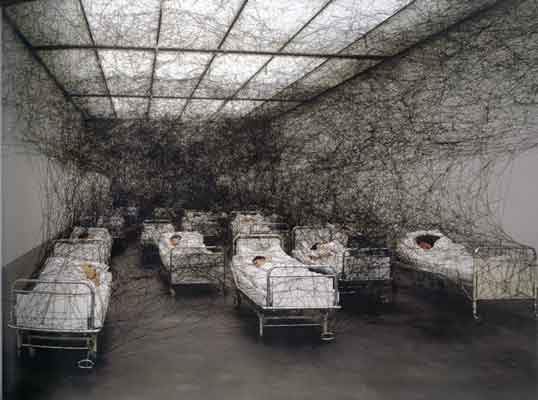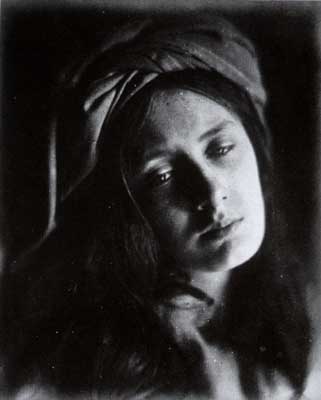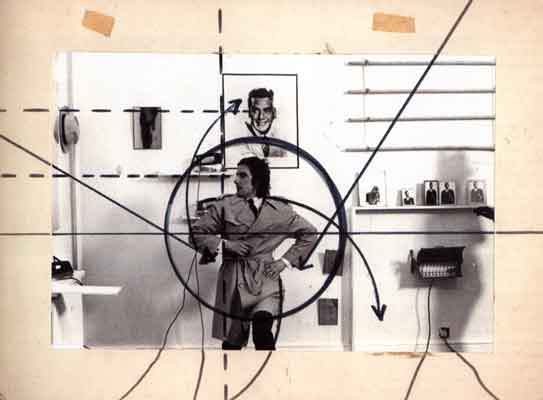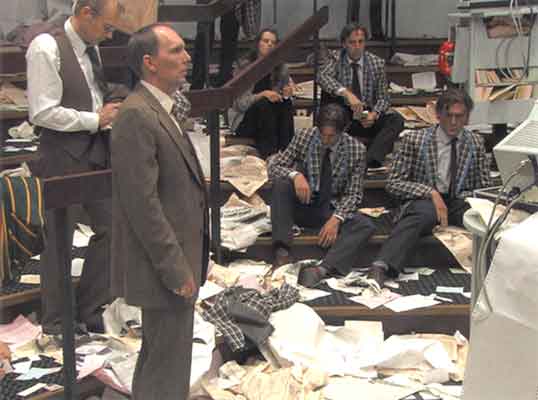
Ferdinand Hodler (1853-1918).
The Dying Valentine Godé-Darel, January 24, 1915.
Oil on canvas, 23.82" x 35.6". Kunstmuseum, Basel.
Another World:Twelve Bedroom Stories and Tableaux Vivants: Living Pictures and Attitudes in Photography, Video, and Filmby Donald Goddard |
|
I saw these exhibitions because I lent several
works by Hannah Wilke, some of which I was also involved in creating, to both
of them. Now, despite that involvement, I don't want not to write about them.
The shows themselves are too interesting to move on without saying something.
Unusually for group shows, there is enough work by each artist to convey a range
of their sensibilities, but more importantly the curatorial ideas are original,
historically literate, and sufficient to encompass the complex reality represented
by each work of art and to suggest relationships among them.
|
 Ferdinand Hodler (1853-1918). The Dying Valentine Godé-Darel, January 24, 1915. Oil on canvas, 23.82" x 35.6". Kunstmuseum, Basel. |
| In a sense, the two exhibitions are opposites. Another World devolves toward the horizontal, into the plane, toward death. Tableaux Vivants emerges toward the vertical, out of the plane, toward life. Both are between; both are conscious of limits. Paradoxically, Another World has several installations or pieces in three dimensions; Tableaux Vivants is all flat, all pictures. Both push into worlds, spaces, that haven't existed or don't exist yet, but will. |
 Hannah Wilke (1940-93). Intra-Venus Series #7, August 18, 1992 (right panel of diptych). Performalist self-portrait with Donald Goddard. Chromogenic supergloss print, 47 1/2" x 71 1/2". Courtesy Ronald Feldman Fine Arts. |
|
The bed is the site of Another World. "It is there that the boundaries of our life are crossed," writes curator and director of the Kunstmusem Luzern Peter Fischer in his introduction to the catalogue. "Birth, sleep, dream, nightmare, memory, rapture, renewal, death--these events or conditions all open avenues to new worlds beyond the control of the conscious." The bed is an alternative reality, literally in Bed Peace (Montreal Bed-In), Yoko Ono's and John Lennon's 74-minute film of 1969, in which the artists, in bed, in their bedclothes, answer questions from the press about war and peace, love and politics. The reality that we credit, of course, is working, building cities, making deals, making war. Bed in that context is frivolous and unimportant, a side issue, really, that has only to do with private experience. And yet, war, for instance, is universally understood to be bad though necessary, while procreation, sleep, dreams, even nightmares, are understood to be necessary and good. Death is simply necessary, though in a strange twist, better arrived at heroically than peacefully, whether in bed or on the battlefield, though, again, most people would rather die peacefully. So, on the whole, it seems reasonable to take to bed, to "give peace a chance." |
 Chiharu Shiota (1972- ). During Sleep, 2002. 20 beds, woollen yarn, dimension variable. Performance, July 14, 2002, Kunstmuseum Luzern. Courtesy Chiharu Shiota and Prüss and Ochs Gallery, Berlin. |
|
Bed is a necessity but also, in the context of this exhibition, a medium, like a painting or video, the site of art, of the imagination. In Ono and Lennon it replaces a conference table or war room. Ferdinand Hodler painted horizontal pictures of his mistress, Valentine Godé-Darel, in bed dying unconsciously of cancer in 1914-15, which pictures, as Fischer points out, became increasingly abstract and landscape-like, art-like. Hodler entered a realm in which aesthetics and reality, whatever that might be for the artist and his subject, are inseparable. The rigid lines of the bed, body, and face are synonymous with the structure of the paintings and drawings themselves. Neither is there separation in the "Intra-Venus" photographs of Hannah Wilke, with which I helped in the last one-and-a-half years of Hannah's life and our life together (1991-93), only now artist and subject are the same. Consciousness is fully embodied and also includes, embraces, my conscience and that of everyone who looks at her.The lymphoma that is killing her becomes another form of life. As in her earlier photographic work (several are in the Vienna show), involving me and others, she exists inasmuch as she is seen, and she is seen, and known, because she defines completely the space in which she exists. The bed is like a sanctuary, a garden, where the body survives, just as Hannah survived and determined the coordinates in other settings. |
| Chiharu Shiota actually occupied one of the twenty hospital beds in her installation on the first day of the show--motionless, eyes closed--then was joined by women laying in the nineteen other beds on the second day. Subsequently, only the beds remained, tied to each other, the walls, and ceilings by a web cloud of black yarn, like the tangle of string with which Marcel Duchamp tied together the works in a Surrealist show in New York in 1942, during World War II. The environment takes over the room, so that ultimately the artist's consciousness, which was once at the center of this work, becomes all-consuming, an inescapable condition, and no longer identifiable with an individual. |
|
For the rest, the bed is metaphor and tabula
rasa; the body turns away or disappears entirely. The figures in Eric Fischl's
bedroom paintings are seen from the side or back in flickering light; sexual
encounters watched from outside, from a distance, from a dark corner of the room.
The head of someone in Roman Signer's video, perhaps the artist himself, is barely
visible under the covers of a spartan bed as he is threatened by the random movements
of a toy remote helicopter. Louise Bourgeois recounts her memories in insomniac
drawings and room constructions that represent a kind of haunted sexuality and
remembered hope. David Reed digitally inserts a painting of his in a scene from
Alfred Hitchcock's Vertigo, then rematerializes the scene as an installation
consisting of the painting, a bed, and a TV playing the altered scene of Scottie's
Bedroom. Reed dematerializes into movie space, Ilona Németh into
sound in Polyfunctional Woman (Get Laid!), and Pipilotti Rist into outer
space, in Extremitäten (weich, wiech).
|
 Julia Margaret Cameron (1815-79). Beatrice, 1866. Albumin print from glass negative, 13" x 10 1/2". National Museum of Photography, Film, and Television, Bradford, UK. |
|
And finally, there is the bed itself. Rebecca Horn's Lover's Bed is an old metal frame lit upon by a few mechanized blue butterflies that flap their wings and seem to play a transcendental role. On the other hand, Mona Hatoum's three baby's cribs--Incommunicado, Silence, and Marrow--and Robert Gober's Bed seem already to have undergone some kind of transubstantiation. All the other works in the exhibition are about entering "another world"; these last works--Hatoum's cribs and Gober's bed--are from another world. It is important that they are beds, but the fact is that they aren't, really. Hatoum's cribs are made of steel, like a cage; glass, something that would splinter and collapse; and rubber, which does collapse. Gober's bed is made of enameled wood with cotton sheets and a wool blanket, all white, but a little small, perhaps for a child, and so normal and neat, with unthreatening rounded corners, that any use of it would be a desecration, or ridiculous. They are ideal, Platonic forms from an ideal, very un-ideal world. There are several allusions to the Classical world in Tableaux Vivants; to the Elgin Marbles in Julia Margaret Cameron; to the Venus de Milo in Man Ray; to Niobe, Europa, Ceres, and Ariadne in Madame Yevonde; to Venus in Hannah Wilke and Valie Export; to the decadence of Rome in Eleanor Antin; to Medusa and Bacchus in Pierre et Gilles; and to Bacchus again in Cindy Sherman. Of course, there are many more allusions to Christian imagery and iconography, but the exhibition, with 35 artists, from Cameron (1815-79) to Jeroen de Rijke (b. 1969) and Willem de Rooij (b. 1970), ranges raucously over the entire range of Western civilization, from the Old Testament to late capitalism. |
 Bruce McLean (1944-). Crease Crisis, 1974. Collage, 6.65" x 9.17". Courtesy of the Artist. |
|
The idea of tableaux vivants itself goes back to the early 19th century, and entails the reenactment of scenes and personages (living pictures) from history and well-known paintings and statuary, usually as an event at upper-class gatherings. It curiously began in the formative years of printed photography, then merged with photography and later with moving pictures and video, spanning the more than 150 years covered in this show. It could be said, I suppose, that any painting or sculpture in the history of art originates from tableaux vivants, renderings from the observation of both art and life--human and animal figures, landscapes, architectural spaces--of narratives and ideas that are, strictly speaking, abstract or without visual feature except as they have been visualized and described in oral tradition and written texts. One can imagine, therefore, the tableaux vivants of the 19th century and onward as reenactments of scenes arranged by the artists of the original works. In today's parlance that would constitute an ironic stance, through which the later artist is able to comment on the methods and beliefs of the original artist. But the irony is not so distant, though the time may be. Tableaux vivants as they were performed in the 19th century might be seen as parlor games, lacking in seriousness and originality. But, of course, they offered something quite unusual to those participating in them and viewing them, besides fun and self-aggrandizement. They offered the possibility of understanding art, human experience, and history through the putative experience and drama of being inside a work of art, which is different than just looking or reading. For an artist this is more than a matter of criticism or learning--or irony. Links with the past are essential, whatever breaks with the past are also essential. Every artist in this exhibition experiences her or his work as parts of dramas that were invented a long time ago and continue to be reinvented. |
 Aernout Mik (1962-). Still from Middlemen, 2001. Videotape transferred to DVD. Courtesy carlier gebauer, Berlin. |
|
The obvious connection, in terms of drama and role-playing, is with theater, but in fact the interest and power of these works lie in their disruption of Aristotelian development, their refusal to conclude. Even the movies and videos are explorations, not narratives, bringing up the same material over and over again, pushing against the moment in extended stills. They come in in the middle, when the scene is full, like a painting, and they stay there, making us live through that middle, without resolution. The artists cast (like sculptors) their characters with full knowledge of what they are taking on--the weight of history, of art, of social position--but also knowing that the roles cannot be played out, that it might be unbearable or simply impossible to do so. Twenty of the 35 artists in the exhibition cast themselves in this position, placing themselves at the center of the dilemma they recognize. Hilarious commentary is made on this moral impasse and aesthetic distinction in a four-minute Pathé Brothers film of 1906, The Miraculous Album, in which an 18th-century courtier entertains his king by turning the drawn figures from a huge album into living figures, one by one, until they become so lively and such a nuisance that the king orders them returned to the book, leaving only their clothes on the ground. That is the lesson of any of the works in this show, that if they were to be fully realized they would burst the bounds not only of expectation and propriety but of social order itself. At least, that is the fear. |
| Julia Margaret Cameron uses photography as a pure evocation of darkness and light, as Victor Hugo wrote to her: "no-one has ever captured the rays of the sun and used them as you have." In her portraits and Biblical and other groupings, eyes and faces emerge from darkness as though from the depths of the past. They do not simply exist in the present, or the present that was then, but are in a sense multiple characters projected, or pulled, into the present. And so it is with all of the artists who follow in this show. The point is not to escape but to feel what being human, or being alive, is like beyond oneself, in art, in life. Marcel Duchamp molds himself into a faun with shaving cream and a woman (Rrose Sélavy) with an enormous hat and cape, identifying himself with the most elemental of human variations rather than that which is immediately and without question acceptable. With the Nice Style Pose Band, Bruce McLean creates a number of absurdist mise-en-scènes, including a 10 1/4-minute film called Crease Crisis (1973), in which he maniacally and obsessively reviews his appearance in a mirror, occasionally ironing parts of his trench coat, in a vain and ultimately useless attempt to emulate the image of the American movie star Victor Mature, whose picture hangs on the wall. In a grid of twenty photographs of herself using a winding sheet (Hannah Wilke Super-T-Art, 1974), Hannah Wilke playfully and unerringly assumes poses from adoration to Crucifixion, processing the history of Western art with extraordinary speed, within a 40-by-30-inch rectangle but more importantly within herself. Liza May Post's film Visitors (1997) has figures moving slowly within an environment of and covered themselves with Oriental rugs, like the one on Freud's couch, as though the motives of human existence, explored by Freud on a primal level, were imbedded in ancient patterns that have no beginning or end. It is interesting, and frightening to someone of my generation, that for artists born after 1960, the last seven in this show, the self is no longer sufficient to contain or bind together the contradictions of history and art. Liza May Post has already entered a world of patterns behind which faces and movements disappear. Joeren de Rijke and Willem de Rooij, in their video Junks (1994-2001), literally come face-to-face with junkies asked not to move, in other words not to exceed the confined space of their condition. Aernout Mik's 21-minute video called Middlemen (2001) pans a roomful of white, younger stock market traders amidst an array of telephones, monitors, railings, and paper littering the floor. Their only movements are halting twitches that in one of the stoical standing figures resembles a heart attack. A few weeks after I saw the show The New York Times had color front-page photos on two different days following New York Stock Exchange plunges that could have been from Mik's video. The artists are equal to the times, but there seems to be very little time left, and very little place for those who would value it. Donald Goddard © 2002 |
Another World will remain through September 29, 2002, at the Kunstmuseum Luzern, Europlatz 1, CH-6002 Luzern, Switzerland. Tel. +41 (0)41 226 78 00. www.kunstmuseumluzern.ch.
Tableaux Vivants will remain through August 28, 2002, at the Kunsthalle wien, Museumplatz 1, A1070 Vienna, Austria. Tel. +43 (1) 52189 12111
Art Reviews Listings - Previous Review - Next Review
Art Review - NYArtWorld.com - NYAW.com. All artwork is copyright of the respective owner or artist. All other material © Copyright 2015 New York Art World ®. All Rights Reserved.
New York Art World ® - Back to Top